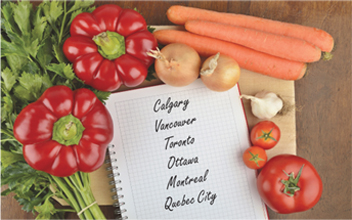Toronto & Ottawa, Ontario
The secret to sounding like a native, according to Bricker, is to not pronounce the second ‘t’ in Toronto. While not the largest city in land area, Toronto is the largest in terms of population with over 5.9 million residents as of 2013. It is located on Lake Ontario across from New York, while Ottawa is in the northeast corner of the province near Quebec.
Bricker describes his home town as the “seat of finance, services, and culture in the country. It’s not a big manufacturing town, not a big industrial town. Basically it’s services and money. So when you talk about Wall Street, we talk about Bay Street,” he explains, noting the many big bank headquarters located there along with the Toronto Stock Exchange.
Bricker believes Toronto is the “most cosmopolitan city in the world” with half of its residents having been born elsewhere. “It’s a huge city, from a North American perspective,” he notes, adding, “It’s our version of New York City or Chicago.”
In contrast, Ottawa is considerably smaller, with a population of just over 1.3 million and like Calgary, its residents rank among the country’s highest median incomes (third, at over $94,000 annually). Bricker says the city is far more attuned to government relations, as the nation’s capital. “It’s our version of Washington, DC,” Bricker says.
Fred Webber, transplanted American and CEO of the Ottawa-based Fruit and Vegetable Dispute Resolution Corporation, agrees. “Like Washington DC, so many bureaucrats and politicians live here it is an economy unto itself.” But the city differs from Washington because it doesn’t have a big suburban population.
“If you look at Washington DC, I don’t know where you’d draw the lines. Here, once you get to the edge of Ottawa, it opens up and you drive hours to the next place.” Webber describes the city as beautiful with plenty of open space and water. “If I was going to take a look at things like bicycle paths and outdoor parks, Ottawa’s pretty high on the list.” It also has what he calls a “heavy European architectural influence.”
“If you’re negotiating major national contracts with the government,” Bricker asserts, “all of that activity takes place in Ottawa.” Other business sectors are negligible. Interestingly, Bricker says many people in the city earn comparable salaries, and “affluence is frowned upon.”
Though the city lies in Ontario, it spans the Ottawa River, brushing up against Quebec, where the province’s official language is French. This has influenced Ottawa as well, as many residents are bilingual (English and French).



